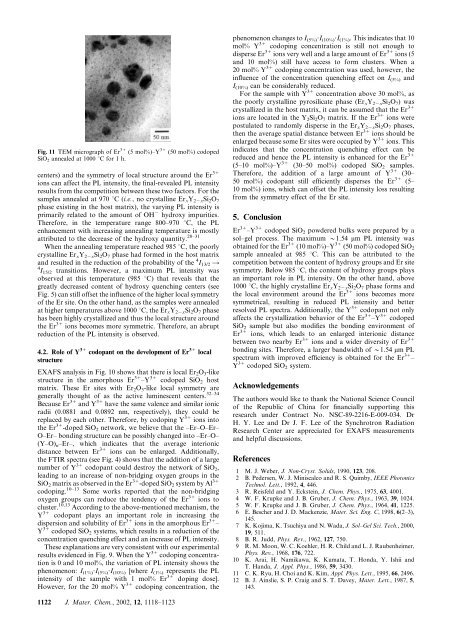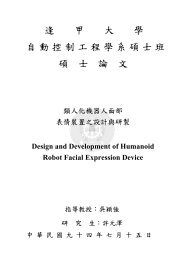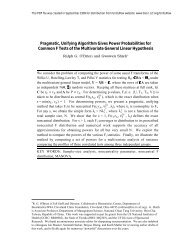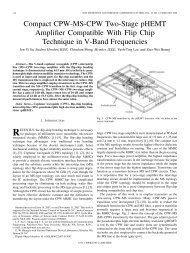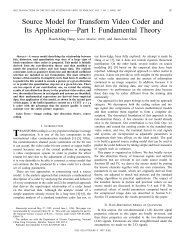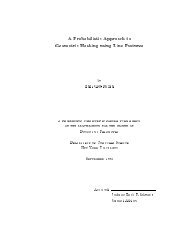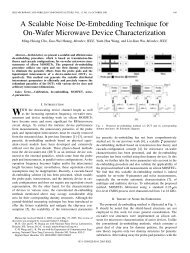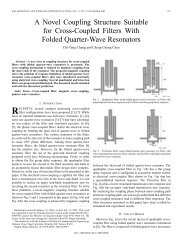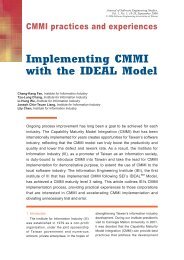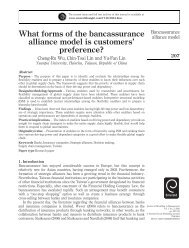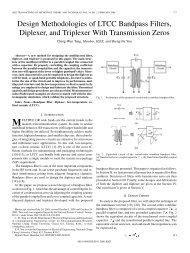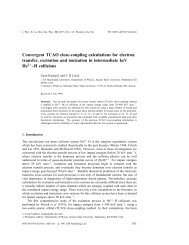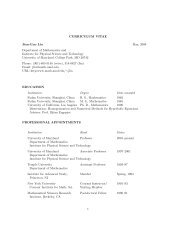doped SiO2 by yttrium codoping
doped SiO2 by yttrium codoping
doped SiO2 by yttrium codoping
You also want an ePaper? Increase the reach of your titles
YUMPU automatically turns print PDFs into web optimized ePapers that Google loves.
Fig. 11 TEM micrograph of Er 31 (5 mol%)–Y 31 (50 mol%) co<strong>doped</strong><br />
SiO 2 annealed at 1000 uC for 1 h.<br />
centers) and the symmetry of local structure around the Er 31<br />
ions can affect the PL intensity, the final-revealed PL intensity<br />
results from the competition between these two factors. For the<br />
samples annealed at 970 uC (i.e., no crystalline Er x Y 22x Si 2 O 7<br />
phase existing in the host matrix), the varying PL intensity is<br />
primarily related to the amount of OH 2 hydroxy impurities.<br />
Therefore, in the temperature range 800–970 uC, the PL<br />
enhancement with increasing annealing temperature is mostly<br />
attributed to the decrease of the hydroxy quantity. 28–31<br />
When the annealing temperature reached 985 uC, the poorly<br />
crystalline Er x Y 22x Si 2 O 7 phase had formed in the host matrix<br />
and resulted in the reduction of the probability of the 4 I 13/2 A<br />
4 I 15/2 transitions. However, a maximum PL intensity was<br />
observed at this temperature (985 uC) that reveals that the<br />
greatly decreased content of hydroxy quenching centers (see<br />
Fig. 5) can still offset the influence of the higher local symmetry<br />
of the Er site. On the other hand, as the samples were annealed<br />
at higher temperatures above 1000 uC, the Er x Y 22x Si 2 O 7 phase<br />
has been highly crystallized and thus the local structure around<br />
the Er 31 ions becomes more symmetric. Therefore, an abrupt<br />
reduction of the PL intensity is observed.<br />
4.2. Role of Y 31 codopant on the development of Er 31 local<br />
structure<br />
EXAFS analysis in Fig. 10 shows that there is local Er 2 O 3 -like<br />
structure in the amorphous Er 31 –Y 31 co<strong>doped</strong> SiO 2 host<br />
matrix. These Er sites with Er 2 O 3 -like local symmetry are<br />
generally thought of as the active luminescent centers. 32–34<br />
Because Er 31 and Y 31 have the same valence and similar ionic<br />
radii (0.0881 and 0.0892 nm, respectively), they could be<br />
replaced <strong>by</strong> each other. Therefore, <strong>by</strong> <strong>codoping</strong> Y 31 ions into<br />
the Er 31 -<strong>doped</strong> SiO 2 network, we believe that the –Er–O–Er–<br />
O–Er– bonding structure can be possibly changed into –Er–O–<br />
(Y–O) n –Er–, which indicates that the average interionic<br />
distance between Er 31 ions can be enlarged. Additionally,<br />
the FTIR spectra (see Fig. 4) shows that the addition of a large<br />
number of Y 31 codopant could destroy the network of SiO 2 ,<br />
leading to an increase of non-bridging oxygen groups in the<br />
SiO 2 matrix as observed in the Er 31 -<strong>doped</strong> SiO 2 system <strong>by</strong> Al 31<br />
<strong>codoping</strong>. 10–13 Some works reported that the non-bridging<br />
oxygen groups can reduce the tendency of the Er 31 ions to<br />
cluster. 10,13 According to the above-mentioned mechanism, the<br />
Y 31 codopant plays an important role in increasing the<br />
dispersion and solubility of Er 31 ions in the amorphous Er 31 –<br />
Y 31 co<strong>doped</strong> SiO 2 systems, which results in a reduction of the<br />
concentration quenching effect and an increase of PL intensity.<br />
These explanations are very consistent with our experimental<br />
results evidenced in Fig. 9. When the Y 31 <strong>codoping</strong> concentration<br />
is 0 and 10 mol%, the variation of PL intensity shows the<br />
phenomenon: I (1%) ?I (5%) ?I (10%) [where I (1%) represents the PL<br />
intensity of the sample with 1 mol% Er 31 doping dose].<br />
However, for the 20 mol% Y 31 <strong>codoping</strong> concentration, the<br />
phenomenon changes to I (5%) ?I (10%) ?I (1%) . This indicates that 10<br />
mol% Y 31 <strong>codoping</strong> concentration is still not enough to<br />
disperse Er 31 ions very well and a large amount of Er 31 ions (5<br />
and 10 mol%) still have access to form clusters. When a<br />
20 mol% Y 31 <strong>codoping</strong> concentration was used, however, the<br />
influence of the concentration quenching effect on I (5%) and<br />
I (10%) can be considerably reduced.<br />
For the sample with Y 31 concentration above 30 mol%, as<br />
the poorly crystalline pyrosilicate phase (Er x Y 22x Si 2 O 7 ) was<br />
crystallized in the host matrix, it can be assumed that the Er 31<br />
ions are located in the Y 2 Si 2 O 7 matrix. If the Er 31 ions were<br />
postulated to randomly disperse in the Er x Y 22x Si 2 O 7 phases,<br />
then the average spatial distance between Er 31 ions should be<br />
enlarged because some Er sites were occupied <strong>by</strong> Y 31 ions. This<br />
indicates that the concentration quenching effect can be<br />
reduced and hence the PL intensity is enhanced for the Er 31<br />
(5–10 mol%)–Y 31 (30–50 mol%) co<strong>doped</strong> SiO 2 samples.<br />
Therefore, the addition of a large amount of Y 31 (30–<br />
50 mol%) codopant still efficiently disperses the Er 31 (5–<br />
10 mol%) ions, which can offset the PL intensity loss resulting<br />
from the symmetry effect of the Er site.<br />
5. Conclusion<br />
Er 31 –Y 31 co<strong>doped</strong> SiO 2 powdered bulks were prepared <strong>by</strong> a<br />
sol–gel process. The maximum y1.54 mm PL intensity was<br />
obtained for the Er 31 (10 mol%)–Y 31 (50 mol%) co<strong>doped</strong> SiO 2<br />
sample annealed at 985 uC. This can be attributed to the<br />
competition between the content of hydroxy groups and Er site<br />
symmetry. Below 985 uC, the content of hydroxy groups plays<br />
an important role in PL intensity. On the other hand, above<br />
1000 uC, the highly crystalline Er x Y 22x Si 2 O 7 phase forms and<br />
the local environment around the Er 31 ions becomes more<br />
symmetrical, resulting in reduced PL intensity and better<br />
resolved PL spectra. Additionally, the Y 31 codopant not only<br />
affects the crystallization behavior of the Er 31 –Y 31 co<strong>doped</strong><br />
SiO 2 sample but also modifies the bonding environment of<br />
Er 31 ions, which leads to an enlarged interionic distance<br />
between two near<strong>by</strong> Er 31 ions and a wider diversity of Er 31<br />
bonding sites. Therefore, a larger bandwidth of y1.54 mm PL<br />
spectrum with improved efficiency is obtained for the Er 31 –<br />
Y 31 co<strong>doped</strong> SiO 2 system.<br />
Acknowledgements<br />
The authors would like to thank the National Science Council<br />
of the Republic of China for financially supporting this<br />
research under Contract No. NSC-89-2216-E-009-034. Dr<br />
H. Y. Lee and Dr J. F. Lee of the Synchrotron Radiation<br />
Research Center are appreciated for EXAFS measurements<br />
and helpful discussions.<br />
References<br />
1 M. J. Weber, J. Non-Cryst. Solids, 1990, 123, 208.<br />
2 B. Pedersen, W. J. Miniscalco and R. S. Quim<strong>by</strong>, IEEE Photonics<br />
Technol. Lett., 1992, 4, 446.<br />
3 R. Reisfeld and Y. Eckstein, J. Chem. Phys., 1975, 63, 4001.<br />
4 W. F. Krupke and J. B. Gruber, J. Chem. Phys., 1963, 39, 1024.<br />
5 W. F. Krupke and J. B. Gruber, J. Chem. Phys., 1964, 41, 1225.<br />
6 E. Bescher and J. D. Mackenzie, Mater. Sci. Eng. C, 1998, 6(2–3),<br />
145.<br />
7 K. Kojima, K. Tsuchiya and N. Wada, J. Sol–Gel Sci. Tech., 2000,<br />
19, 511.<br />
8 B. R. Judd, Phys. Rev., 1962, 127, 750.<br />
9 R. M. Moon, W. C. Koehler, H. R. Child and L. J. Raubenheimer,<br />
Phys. Rev., 1968, 176, 722.<br />
10 K. Arai, H. Namikawa, K. Kumata, T. Honda, Y. Ishii and<br />
T. Handa, J. Appl. Phys., 1986, 59, 3430.<br />
11 C. K. Ryu, H. Choi and K. Kim, Appl. Phys. Lett., 1995, 66, 2496.<br />
12 B. J. Ainslie, S. P. Craig and S. T. Davey, Mater. Lett., 1987, 5,<br />
143.<br />
1122 J. Mater. Chem., 2002, 12, 1118–1123


